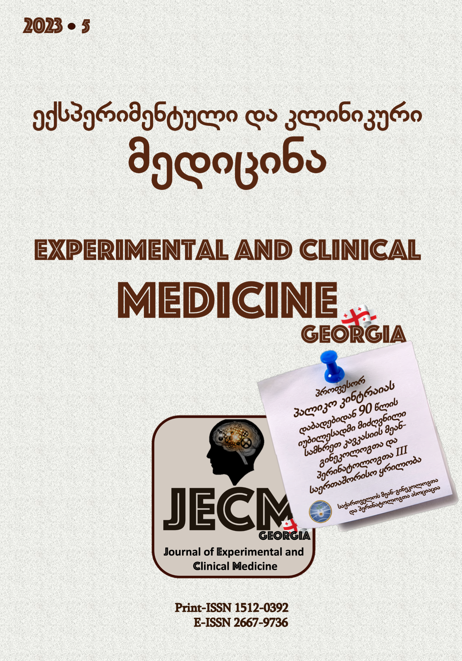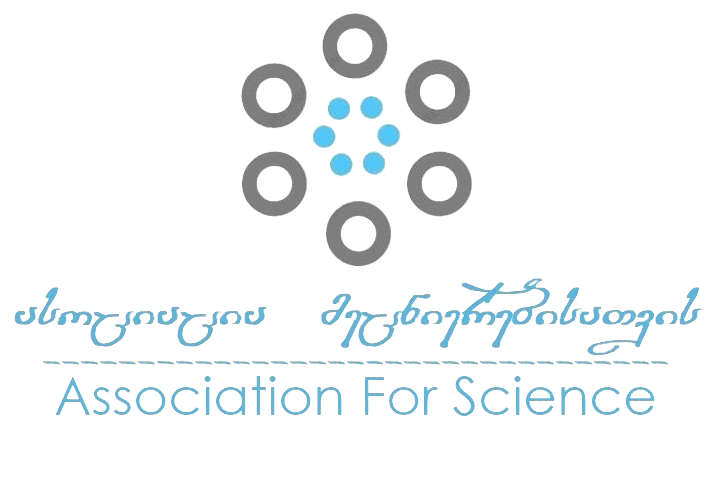ენერგეტიკული ბალანსის როლი პოლიკისტოზური საკვერცხეების სინდრომის განვითარებაში
DOI:
https://doi.org/10.52340/jecm.2023.05.17საკვანძო სიტყვები:
polycystic ovary syndrome, energy balance, calorimetryანოტაცია
ჩვენი კვლევის მიზანს წარმოადგენდა არაპირდაპირი კალორიმეტრიის მეთოდით ენერგეტიკული მაჩვენებლების შეფასება მოზარდებში და პსს-სთან მათი ასოციაციის განსაზღვრა.
კვლევის მეთოდები. ჯვარედინ-სექციური დიზაინის კვლევით შესწავლილ იქნა პსს-ის მქონე სხვადასხვა სხეულის მასის მქონე 50 მოზარდი (ასაკი - 13-19 წწ.). სხეულის იგივე მასისა და ასაკის მქონე 50 მოზარდმა პსს-ის გარეშე შეადგინა საკონტროლო ჯგუფი. როგორც საკვლევი, ისე საკონტროლო ჯგუფის წარმომადგენლები გამოიკითხნენ საკვები რაციონის, კვებითი ჩვევების, ძილისა და ფიზიკური დატვირთვის მონაცემების მიღების მიზნით სპეციალურად შექმნილი კითხვარის მეშვეობით. ენერგეტიკული მაჩვენებლები განისაზღვრა არაპირდაპირი კალორიმეტრიის მეთოდით REEVUE Metacheck (KORRTM, აშშ) აპარატით. მოსვენებულ მდგომარეობაში მეტაბოლური მაჩვენებელი (Resting Metabolic Rate - RMR) განისაზღვრებოდა 10 წუთის განმავლობაში ჩასუნთქულ და ამოსუნთქულ ჰაერის ფრაქციებში ჟანგბადის პროცენტული მნიშვნელობების ფარდობის მიხედვით. ანთროპომეტრიული პარამეტრები შეფასდა სხეულის მასის ინდექსის გამოთვლით ასაკისა და სქესის გათვალისწინებით (პერცენტილეს ცხრილები, ჯანმო, 2002).
შედეგები. RMR მაჩვენებელი, როგორც ძირითად საკვლევ ჯგუფში (1758.5±363.7 კკალ), ისე სხეულის დაბალი (1603.6±274.0 კკალ), ნორმალური (1724.2±356.9 კკალ) და ჭარბი მასის მქონე პაციენტების (2088.0±327.2 კკალ) საკვლევ ქვეჯგუფებში სარწმუნოდ მომატებულია საკონტროლო ქვეჯგუფებთან შედარებით. თუკი RMR მაჩვენებელს შევადარებთ ქვეჯგუფებს შორის, ნათლად ჩანს, რომ სხეულის ჭარბი მასის და პსს-ის საკვლევ ქვეჯგუფში იგი სარწმუნოდ მომატებულია ნორმალური და დაბალი მასის და პსს-ის მქონე საკვლევ პაციენტებთან შედარებით (p<0.001), ნორმალური მასის საკვლევი ქვეჯგუფის მაჩვენებელი კი სარწმუნოდ არ განსხვავდება დაბალი მასის და პსს-ის მქონე პაციენტების მაჩვენებლისგან (p=0.254). საკვლევ ჯგუფში სულ 9 (18%) პაციენტს აღმოაჩნდა მათემატიკური ფორმულებით გამოთვლილ მაჩვენებლებთან შედარებით დაქვეითებული მაჩვენებელი, რაც ჩაითვალა ენერგოდეფიციტურ მდგომარეობად. სხეულის მასის მიხედვით დაყოფილ ქვეჯგუფებში ასეთი მდგომარეობა გადანაწილდა შემდეგნაირად: დაბალი მასა - 6 (33.3%), ნორმალური მასა - 3 (15.0%). სხეულის ჭარბი მასის მქონე პირებში ასეთი მდგომარეობა არ დაფიქსირდა.
გამოკითხვის შედეგად მიღებული მონაცემებით, ქცევითი დარღვევებისა და არაბალანსირებული საკვების კუთხით საკვლევ ჯგუფში საკონტროლოსთან შედარებით სარწმუნოდ მეტი შანსით გამოირჩევიან: ცილებით ღარიბი და ნახშირწყლებით მდიდარი საკვები, საუზმის გამოტოვება, წყვეტილი ძილი, ძილის ხანგრძლივობა (<8 სთ) და ცხოვრების უმოძრაო წესი.
დასკვნა. კვლევის შედეგების საფუძველზე შეიძლება დავასკვნათ, რომ ენერგეტიკული დისბალანსი დიდი ალბათობით არის ერთ-ერთი მნიშვნელოვანი პათოგენეზური რგოლი სხეულის მასის სიჭარბისა და პსს-ის განვითარებაში. იმისათვის, რომ ეს ვარაუდი გადაიქცეს მტკიცებულებად, საჭიროა ჩატარდეს მასშტაბური რანდომიზებული კლინიკური კვლევები.
Downloads
წყაროები
Azziz R, Woods KS, Reyna R, Key TJ, Knochenhauer ES, Yildiz BO. The Prevalence and Features of the Polycystic Ovary Syndrome in an Unselected Population. J Clin Endocrinol Metab 2004, 89(6):2745–2749.
Knochenhauer ES, Key TJ, Kahsar-Miller M, Waggoner W, Boots LR, Azziz R. Prevalence of the Polycystic Ovary Syndrome in Unselected Black and White Women of the Southeastern United States: A Prospective Study. J Clin Endocrinol Metab 1998, 83(9):3078–3082.
Asunción M, Calvo RM, San Millán JL, Sancho J, Avila S, Escobar-Morreale HF. A Prospective Study of the Prevalence of the Polycystic Ovary Syndrome in Unselected Caucasian Women from Spain. J Clin Endocrinol Metab 2000, 85(7):2434–2438.
Diamanti-Kandarakis E, Kouli CR, Bergiele AT, Filandra FA, Tsianateli TC, Spina GG et al. A Survey of the Polycystic Ovary Syndrome in the Greek Island of Lesbos: Hormonal and Metabolic Profile. J Clin Endocrinol Metab 1999, 84(7):4006–4011.
AgaIbáñez L, Oberfield SE, Witchel S, Auchus RJ, Chang RJ, Codner E et al. An International Consortium Update: Pathophysiology, Diagnosis, and Treatment of Polycystic Ovarian Syndrome in Adolescence. Horm Res Paediatr 2017, 88(6):371-395.
Wolf WM, Wattick RA, Kinkade ON, Olfert MD. Geographical Prevalence of Polycystic Ovary Syndrome as Determined by Region and Race/Ethnicity. Int J Environ Res Public Health. 2018, 15(11):2589.
Twig G, Yaniv G, Levine H, Leiba A, Goldberger N, Derazne E, Ben-Ami Shor D, Tzur D, Afek A, Shamiss A, Haklai Z, Kark JD. Body-Mass Index in 2.3 Million Adolescents and Cardiovascular Death in Adulthood. N Engl J Med 2016, 374(25):2430-40.
Barry JA, Azizia MM, Hardiman PJ. Risk of endometrial, ovarian and breast cancer in women with polycystic ovary syndrome: a systematic review and meta-analysis. Hum Reprod Update 2014, 20(5):748-58.
Ding DC, Chen W, Wang JH, Lin SZ. Association between polycystic ovarian syndrome and endometrial, ovarian, and breast cancer: A population-based cohort study in Taiwan. Medicine (Baltimore) 2018, 97(39):e12608.
Li L, Feng Q, Ye M, He Y, Yao A, Shi K. Metabolic effect of obesity on polycystic ovary syndrome in adolescents: a meta-analysis. J Obstet Gynaecol 2017 37(8):1036-1047.
Ovesen P, Moller J, Ingerslev HJ, Jørgensen JO, Mengel A, Schmitz O et al. Normal basal and insulin-stimulated fuel metabolism in lean women with the polycystic ovary syndrome. J Clin Endocrinol Metab 1993, 77(6):1636-40.
Engmann L, Jin S, Sun F, Legro RS, Polotsky AJ, Hansen KR et al. Reproductive Medicine Network. Racial and ethnic differences in the polycystic ovary syndrome metabolic phenotype. Am J Obstet Gynecol 2017, 216(5):493.e1-493.e13.
Apter D, Bützow T, Laughlin GA, Yen SS. Metabolic features of polycystic ovary syndrome are found in adolescent girls with hyperandrogenism. J Clin Endocrinol Metab 1995, 80(10):2966-73.
Xu T, Zhu G, Han S. Prevalence of Suboptimal Health Status and the Relationships between Suboptimal Health Status and Lifestyle Factors among Chinese Adults Using a Multi-Level Generalized Estimating Equation Model. Int J Environ Res Public Health 2020;17(3):763.
Wu S, Xuan Z, Li F, Xiao W, Fu X, Jiang P, Chen J, Xiang L, Liu Y, Nie X, Luo R, Sun X, Kwan H, Zhao X. Work-Recreation Balance, Health-Promoting Lifestyles and Suboptimal Health Status in Southern China: A Cross-Sectional Study. Int J Environ Res Public Health. 2016 Mar 19;13(3):339. doi: 10.3390/ijerph13030339. PMID: 27007383; PMCID: PMC4809002.
Lim SS, Norman RJ, Davies MJ, Moran LJ. The effect of obesity on polycystic ovary syndrome: a systematic review and meta-analysis. Obes Rev. 2013;14(2):95–109.
Moran LJ, Misso ML, Wild RA, Norman RJ. Impaired glucose tolerance, type 2 diabetes and metabolic syndrome in polycystic ovary syndrome: a systematic review and meta-analysis. Hum Reprod Update. 2010;16(4):347–363.
Ehrmann DA. Polycystic ovary syndrome. N Engl J Med. 2005;352(12):1223–1236.
Dunaif A, Scott D, Finegood D, Quintana B, Whitcomb R. The insulin-sensitizing agent troglitazone improves metabolic and reproductive abnormalities in the polycystic ovary syndrome. J Clin Endocrinol Metab. 1996;81(9):3299–3306.
Hall KD, Heymsfield SB, Kemnitz JW, Klein S, Schoeller DA, Speakman JR. Energy balance and its components: implications for body weight regulation. Am J Clin Nutr. 2012;95(4):989–994
Heymsfield SB, Darby PC, Muhlheim LS, Gallagher D, Wolper C, Allison DB. The calorie: myth, measurement, and reality. Am J Clin Nutr. 1995;62(5 Suppl):1034S–1041S.
Rosenbaum M, Ravussin E, Matthews DE, Gilker C, Ferraro R, Heymsfield SB, Hirsch J, Leibel RL. A comparative study of different means of assessing long-term energy expenditure in humans. Am J Physiol. 1996;270(3 Pt 2):R496–R504.
Schoeller DA. Measurement of energy expenditure in free-living humans by using doubly labeled water. J Nutr. 1988;118(11):1278–1289.
Robinson S, Chan SP, Spacey S, Anyaoku V, Johnston DG, Franks S. Postprandial thermogenesis is reduced in polycystic ovary syndrome and is associated with increased insulin resistance. Clin Endocrinol (Oxf). 1992;36:537-543.
Romualdi D, Versace V, Tagliaferri V, et al. The resting metabolic rate in women with polycystic ovary syndrome and its relation to the hormonal milieu, insulin metabolism, and body fat distribution: a cohort study. J Endocrinol Invest. 2019;42:1089-1097.
Sellix MT, Menaker M. Circadian clocks in mammalian reproductive physiology: effects of the "other" biological clock on fertility. Discov Med 2011; 11(59):273-81.
Pendergast FJ, Livingstone KM, Worsley A, McNaughton SA. Correlates of meal skipping in young adults: a systematic review. Int J Behav Nutr Phys Act 2016; 13(1):125-39.
Bowen J, Brindal E, James-Martin G, Noakes M. Randomized Trial of a High Protein, Partial Meal Replacement Program with or without Alternate Day Fasting: Similar Effects on Weight Loss, Retention Status, Nutritional, Metabolic, and Behavioral Outcomes. Nutrients 2018; 10(9):1145-60.






